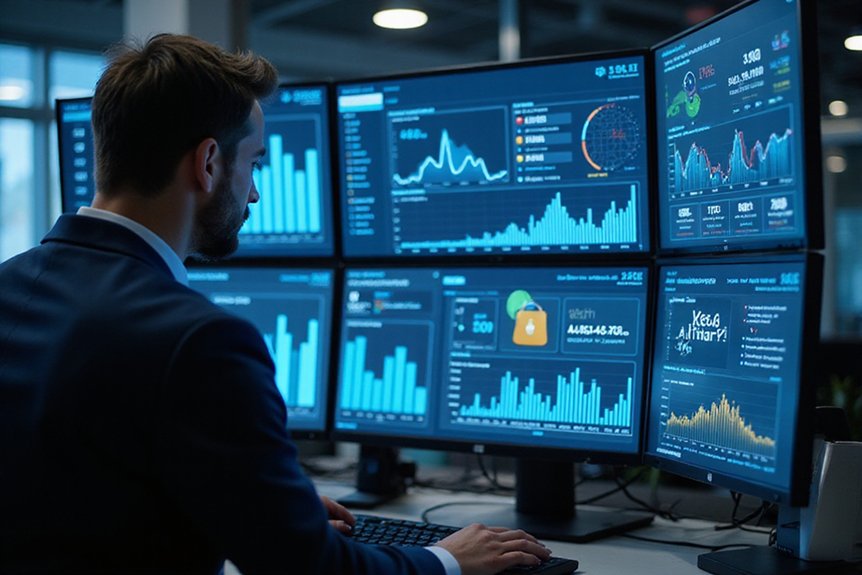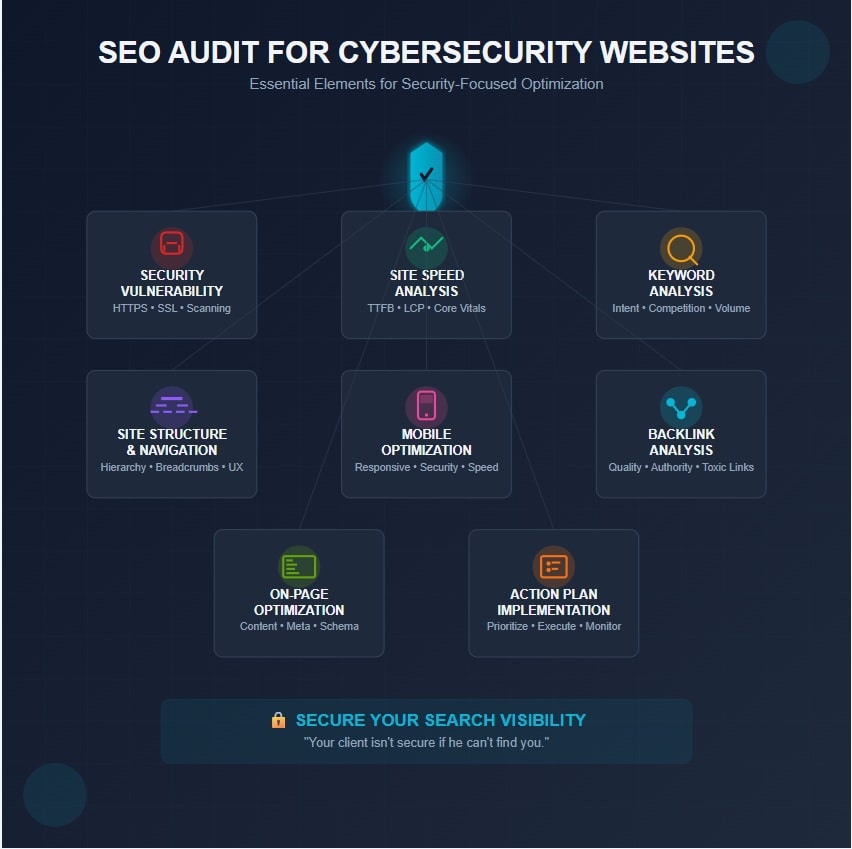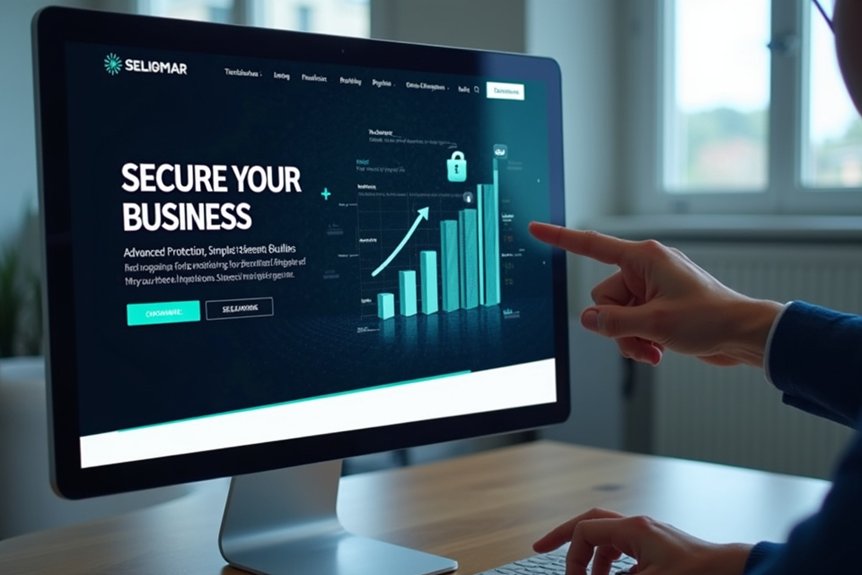Why Is an SEO Audit for Cybresecurity Websites Important?
Cybersecurity websites face unique SEO challenges that conventional auditing approaches often overlook. Technical vulnerabilities, rapidly evolving industry terminology, and heightened user trust concerns require specialized assessment methodologies beyond standard optimization practices. In addition, the intersection of security credibility and search visibility demands meticulous analysis of both on-page factors and backlink quality, where compromised connections could potentially damage reputation and rankings simultaneously. Organizations must consider how their SEO strategy aligns with security positioning without compromising sensitive information architecture or technical safeguards. An SEO audit for Cybersecurity Websites will give you the information you need to take action!
Key Takeaways
- Assess security vulnerability alongside SEO metrics, focusing on HTTPS implementation and SSL certificates to boost security credibility and rankings.
- Evaluate site speed using Core Web Vitals, particularly Time to First Byte and Largest Contentful Paint for optimal performance.
- Analyze information architecture with strategic keyword placement and breadcrumb navigation to enhance content discoverability.
- Perform quality backlink assessments to establish domain authority, targeting 572,665 backlinks for industry benchmark compliance.
- Implement continuous monitoring systems to validate link authenticity and remove toxic links that compromise security credibility.
Understanding SEO Audit Requirements for Cybersecurity Sites

Why do cybersecurity websites require specialized SEO audit approaches that differ from standard digital marketing practices? The inherent complexity of security solutions, coupled with rapidly evolving threat landscapes, necessitates a tailored strategy that addresses industry-specific challenges.
When conducting extensive audits, professionals must implement systematic content updates that align with current security protocols, while simultaneously developing robust keyword mapping frameworks that capture highly technical terminology. Regular security audits can help identify and address potential cyber threats before they can be exploited by malicious actors. Additionally, over 7 billion searches conducted on Google daily highlight the importance of optimizing content for visibility in a competitive environment.
In addition, the credibility requirements for cybersecurity content exceed typical industry standards, as inaccurate or outdated information could potentially compromise organizational security postures, thereby requiring meticulous verification processes and authoritative language throughout all digital assets.
Evaluating Technical Security and SEO Performance
When examining cybersecurity websites, a thorough analysis must include both security vulnerability assessments and broader SEO performance metrics, which, when evaluated together, establish a foundation for prioritizing technical improvements.
Site speed analysis, particularly focused on Time to First Byte (TTFB) and Largest Contentful Paint (LCP), reveals crucial optimization opportunities that simultaneously enhance user experience and search visibility while reducing potential attack vectors. Implementing HTTPS security is essential for cybersecurity websites as it directly impacts both user trust and Google’s ranking factors. Additionally, moving up a single position in Google search results can significantly increase the click-through rate, further emphasizing the importance of site optimization.
Furthermore, mobile index performance, as measured through Core Web Vitals and mobile-responsive design implementation, requires special attention for cybersecurity sites, given that Google’s mobile-first indexing determines ranking potential and security credibility in an increasingly smartphone-dominated search landscape.
Security Vulnerability Assessment
The thorough evaluation of an organization’s cybersecurity infrastructure represents a critical foundation for both technical security integrity and search engine optimization performance.
Security vulnerability assessment, which encompasses the systematic identification and analysis of various vulnerability types across digital assets, enables organizations to quantify risk exposure before malicious actors can exploit weaknesses.
This process, involving asset discovery and prioritization followed by extensive scanning, establishes a protective framework that not only safeguards sensitive data but also indirectly enhances SEO performance through improved user trust, site credibility, and uninterrupted service availability—factors increasingly weighted in search engine algorithms that prioritize secure, reliable digital experiences. Modern security protocols often incorporate web application scanners that automatically test for known attack patterns to ensure comprehensive protection against evolving threats.
Site Speed Analysis
Beneath the surface of every high-performing cybersecurity website lies a meticulously optimized infrastructure that balances technical security protocols with seamless user experience.
When conducting a thorough SEO audit, professionals must evaluate load time optimization metrics—including Time To First Byte (TTFB), Largest Contentful Paint (LCP), and Total Blocking Time (TBT)—which collectively impact search engine rankings and user engagement.
Server performance, encompassing proper SSL/TLS configuration and HTTP/2 adoption, represents a crucial intersection of security and speed, while regularly measuring Core Web Metrics through tools like WebPageTest and GTmetrix enables cybersecurity firms to maintain competitive advantage through continuous optimization initiatives. Proper implementation of high encryption percentages across website data transfers contributes to both user trust and SEO performance, with encrypted data percentages serving as a key metric for both security posture and search visibility.
Mobile Index Performance
Modern cybersecurity websites face a dual imperative within the mobile ecosystem: maintaining robust security protocols while simultaneously optimizing for Google’s mobile-first indexing approach, which now dominates the search landscape.
The intersection of security and SEO impact requires careful analysis of multiple critical factors:
- Implement responsive design that adapts to various device screens while maintaining secure elements.
- Optimize page loading efficiency, as this affects both mobile user experience and search rankings.
- Ascertain HTTPS implementation, which serves both as a ranking signal and security necessity.
- Deploy mobile-specific analytics to track potential vulnerabilities while monitoring SEO performance.
Notably, cybersecurity sites must address the 83% phishing threat targeting mobile users, which, when properly mitigated, can substantially improve both security posture and search visibility. Understanding the quality of service metrics featured in the GSMA Mobile Connectivity Index provides valuable benchmarks for security performance evaluation.
Keyword Analysis for Cybersecurity Products and Services
Effective keyword strategy forms the cornerstone of successful SEO campaigns for cybersecurity websites, particularly when optimizing for products and services that require targeted visibility in an increasingly competitive digital landscape.
Thorough keyword research, when paired with meticulous competitor analysis, reveals valuable opportunities in high-volume terms (110,000 monthly searches for “cyber security”) and product-specific variations like “cloud computing security.” Additionally, SEO drives 1,000%+ more traffic than organic social media, highlighting the importance of effective keyword targeting.
Furthermore, keyword targeting must align with search intent across IT professionals, executives, and compliance officers, incorporating both transactional and informational queries to maximize relevance and conversion potential. Segmenting keywords into specific categories such as network security and data protection helps create more focused content that addresses the unique needs of different cybersecurity market segments.
Site Structure and Navigation Assessment for Security Websites

While cybersecurity websites must convey complex technical information, their structural foundation and navigational framework require meticulous optimization to support both user experience and search engine accessibility. Effective information architecture, which organizes content hierarchically through intuitive categorization systems, enables visitors to efficiently locate critical security resources while facilitating search engine crawlability.
Key elements for navigation optimization include:
- Implementation of breadcrumb navigation to reinforce content hierarchy and improve user flow
- Strategic internal linking that connects related security concepts and solutions
- Integration of accessibility standards to guarantee compliance while enhancing SEO performance
- Security integration within the site structure, including HTTPS implementation and proper form validation
Incorporating multi-factor authentication capabilities within the site structure not only demonstrates security best practices but also serves as an example of the protective measures the organization advocates for its users.
Mobile Security and Responsiveness Optimization
When conducting a thorough SEO audit for cybersecurity websites, evaluating the mobile security posture and responsiveness optimization becomes critical, particularly as mobile traffic now dominates online interactions at nearly 60% of global website visits.
Through systematic testing of potential mobile vulnerabilities, including unsecured Wi-Fi connections and outdated encryption protocols, security websites can demonstrate expertise while simultaneously improving their search visibility.
Implementing responsive design elements that adapt to various screen sizes, alongside accelerated performance tactics such as AMP implementation and compression technologies, creates a dual benefit of enhancing user experience and strengthening technical SEO signals that search engines increasingly prioritize in ranking decisions.
With an average of 115 CVEs disclosed daily by late 2024, cybersecurity websites must implement continuous monitoring features that alert mobile users to emerging threats in real-time to maintain credibility and search relevance.
Testing Mobile Vulnerabilities
Thorough mobile vulnerability testing forms the foundation of robust cybersecurity protocols for organizations seeking to protect sensitive data and maintain operational integrity across their digital ecosystems.
Implementing extensive mobile testing strategies, which incorporate both automated vulnerability scanning tools and manual review processes, guarantees that potential security weaknesses are identified before they can be exploited by malicious actors. Following the OWASP MASVS standard ensures comprehensive security validation against industry-recognized threats and vulnerabilities.
- Deploy static analysis tools (MobSF, JADX) to identify code-level vulnerabilities
- Implement dynamic testing with Burp Suite to simulate attack vectors
- Utilize runtime analysis frameworks like Frida to monitor application behavior
- Integrate continuous security testing into development pipelines using NowSecure
Responsive Design Elements
Effective responsive design serves as the critical foundation for cybersecurity websites that must maintain both security integrity and ideal user experience across diverse device environments.
When conducting an SEO audit, security professionals must evaluate if flexible layouts utilize relative units rather than fixed pixels, ensuring content adapts proportionally to various screen sizes without compromising security elements or user trust indicators.
Furthermore, responsive typography implementation, which employs em and rem units for scalable text rendering, directly impacts both user engagement metrics and security credibility factors, particularly when displaying critical security notifications, privacy policies, or SSL certificate information that must remain legible across all devices regardless of viewport constraints. Implementing a card-based UI design allows security features and critical information to be effectively organized into modular, rearrangeable sections that adapt seamlessly across different device sizes while maintaining visual hierarchy of security elements.
Accelerated Performance Tactics
Milliseconds matter profoundly in the cybersecurity ecosystem, where loading delays not only impact user engagement metrics but potentially compromise critical security operations on mobile platforms.
Accelerated performance, which includes both code minification and image optimization techniques, represents a vital component of security-focused websites that must balance responsiveness with protective capabilities. Regular performance audits using tools like Google Lighthouse help identify and rectify security vulnerabilities while maintaining optimal loading speeds.
The most effective performance acceleration tactics include:
- Implementing HTTPS encryption while utilizing CDNs to distribute security content with minimal latency
- Employing aggressive image optimization without compromising visual clarity of security interfaces
- Executing thorough code minification to reduce payload size and potential attack surfaces
- Leveraging browser caching protocols to enhance repeat visitor experiences while maintaining security posture
On-Page SEO Elements for Cybersecurity Content
Optimizing on-page elements for cybersecurity websites requires meticulous attention to technical details that align with both search engine algorithms and user expectations, particularly in an industry where trust and expertise are paramount considerations for potential clients seeking protection against digital threats. According to experts, effective link-building tactics such as digital PR can significantly enhance a website’s authority and visibility.
Effective on-page optimization necessitates strategic keyword placement within header tags, meta descriptions, and body content, while simultaneously demonstrating expertise through authoritative content strategy that addresses specific cybersecurity concerns.
To maximize visibility, cybersecurity websites should implement schema markup that clearly delineates service offerings, incorporate SSL certificates that signal trustworthiness, and structure URLs with relevant keywords that improve both user experience and search engine understanding. Implementing strong security protocols is essential not only for protecting user data but also for preserving SEO rankings while maintaining user trust in the cybersecurity domain.
Backlink Profile Analysis and Security Verification

A thorough backlink profile analysis examines quality indicators, including domain authority and relevance, while identifying potentially toxic links that could trigger security penalties or algorithmic downgrades.
When conducting security verification for cybersecurity websites, SEO professionals must authenticate that backlink sources maintain proper SSL certificates, HTTPS compliance, and freedom from malicious code or phishing elements. Implementing reCAPTCHA verification can further protect these websites from unauthorized bot access and ensure the integrity of user interactions.
Through systematic evaluation of competitors’ backlink strategies, cybersecurity firms can identify high-value link opportunities within industry directories, authoritative publications, and relevant forums, thereby establishing both search visibility and domain trustworthiness.
Backlink Quality Assessment
When evaluating a cybersecurity website’s SEO performance, the meticulous assessment of backlink quality represents one of the most critical components for establishing domain authority and trustworthiness in search engine rankings.
A thorough evaluation through backlink auditing requires analyzing multiple dimensions, including domain relevance and link stability. These collectively determine whether connections enhance or diminish site credibility within the specialized cybersecurity ecosystem. With cybersecurity startups requiring an average of 572,665 backlinks to meet industry standards, the emphasis on quality becomes even more crucial.
- Examine anchor text diversity ratios, ensuring balanced distribution between branded, generic, and keyword-rich variants.
- Verify SSL certification status of all linking domains.
- Assess content quality surrounding backlink placements.
- Calculate domain and page authority metrics of referring sites.
Toxic Link Identification
Identifying toxic backlinks remains a foundational component of thorough SEO auditing for cybersecurity websites, where reputation and trustworthiness directly impact both search visibility and user confidence.
Through extensive analysis using specialized tools like Semrush Backlink Audit, professionals can identify current toxic link trends that may trigger Google penalties, with over 58.1% of SEO practitioners emphasizing link quality’s critical importance.
During assessment, particular attention must be directed toward spammy anchor texts, including irrelevant content connections, keyword-stuffed phrases, and suspiciously generic terminology such as “click here.” Regular link profile monitoring helps maintain website credibility and prevents potential search engine penalties that could damage your digital presence.
For effective remediation, cybersecurity websites should implement both manual removal processes and strategic disavow procedures, followed by regular audit cycles to maintain link profile integrity.
Security Credential Verification
Security credential verification represents an increasingly important dimension of SEO strategy for cybersecurity websites, extending beyond traditional backlink quality assessment into the area of thorough security posture evaluation.
Implementing credential audits, when combined with advanced MFA strategies and robust access controls, creates a detailed defense against infostealer prevention while simultaneously improving domain authority.
Effective security credential verification includes:
- Establishing regular dark web monitoring protocols to detect compromised credentials before exploitation
- Implementing mandatory cybersecurity training focused on credential management
- Developing risk mitigation frameworks specifically addressing backlink vulnerabilities
- Enforcing security best practices through automated verification systems that validate link authenticity
This multifaceted approach, which necessarily incorporates both technical safeguards and procedural controls, represents the evolving intersection between SEO optimization and cybersecurity defense. Using tools like AWStats can help identify suspicious activity patterns in website log files that might indicate security breaches affecting SEO performance.
Page Speed and Performance Testing for Security Software
In today’s competitive digital landscape, performance enhancement represents a critical factor for cybersecurity websites, particularly as users expect near-instantaneous page loading while simultaneously demanding robust security measures.
The inherent tension between detailed security tools and ideal Page Speed requires deliberate optimization techniques that balance protection with performance metrics.
Security professionals must implement image optimization, code minification, and HTTP request reduction while carefully managing security software overhead.
Performance testing tools such as Google PageSpeed Insights and WebPageTest provide essential diagnostics for identifying security-related bottlenecks. Implementing a reliable content delivery network can significantly improve loading times for security websites by caching content closer to users worldwide.
Through asynchronous loading, browser caching implementation, and regular security plugin optimization, cybersecurity websites can maintain both protective integrity and competitive loading times.
Implementing Schema Markup for Cybersecurity Companies
While digital visibility represents an ongoing challenge for cybersecurity providers, schema markup offers a sophisticated solution that substantially enhances search engine understanding of specialized security content.
Through meticulously structured data implementation, organizations can establish precise brand representation while simultaneously achieving multiple competitive advantages, including improved local SEO performance and voice search optimization. By creating a connected Schema Markup, cybersecurity companies can form a reusable Content Knowledge Graph that defines their security solutions as entities with properties and interrelationships. Additionally, 68% of online experiences begin with a search engine, highlighting the importance of optimized visibility.
Structured data empowers cybersecurity brands with precision representation while unlocking competitive SEO advantages across multiple channels.
Four critical schema benefits for cybersecurity websites include:
- Enhanced rich snippets displaying security certifications and service ratings
- Improved contextual understanding of technical security offerings
- Strategic positioning in knowledge graphs for authoritative industry representation
- Increased user engagement through specialized schema examples like FAQPage for security concerns
Creating an Action Plan to Address SEO Vulnerabilities

Developing an effective remediation strategy requires cybersecurity organizations to systematically identify, prioritize, and address SEO vulnerabilities through a structured, data-driven approach that balances immediate tactical fixes with long-term strategic improvements.
After generating actionable insights through thorough audits, security professionals should implement a three-tiered vulnerability prioritization framework: critical issues affecting rankings or security, moderate concerns impacting user experience, and minor optimizations for competitive advantage.
Subsequently, organizations must establish measurable objectives with specific timelines, allocate appropriate resources for implementation, and develop monitoring protocols to track progress against established KPIs, ensuring continuous refinement of SEO strategies based on performance analytics.
Implementing robust technical SEO practices will significantly improve site crawlability and enhance the overall user experience, which directly impacts search rankings for cybersecurity websites.
Look At an SEO Audit for Your Cybersecurity Website Today!
Effective SEO audits for cybersecurity websites require meticulous attention to technical security parameters, industry-specific keyword optimization, and structural integrity assessments that align with evolving threat landscapes. Through thorough evaluation of performance metrics, implementation of schema markup, and strategic backlink verification, organizations can systematically address vulnerabilities while enhancing visibility among security-conscious audiences. The resulting action plan serves as a foundational roadmap for continuous optimization within this specialized sector’s unique digital marketing requirements.

Frequently Asked Questions
How Does GDPR Compliance Impact Cybersecurity Website SEO Performance?
GDPR implications positively influence cybersecurity website SEO through enhanced user trust. Data protection compliance reduces bounce rates, increases engagement metrics, and prevents penalties—ultimately strengthening digital visibility and competitive positioning in search rankings.
Can Privacy-Focused Analytics Alternatives Effectively Replace Google Analytics?
Privacy-focused analytics alternatives can effectively replace Google Analytics by offering compliant user tracking while maintaining data ownership. Tools like Plausible and Fathom deliver essential insights despite some feature limitations compared to mainstream solutions.
How Frequently Should Cybersecurity Companies Update SEO Strategies?
Cybersecurity companies should update SEO strategies quarterly for thorough reviews, with monthly keyword optimization assessments and immediate adjustments following major security events to maintain content freshness and competitive advantage in rapidly evolving threat landscapes.
Do Security Badges and Trust Indicators Affect SEO Rankings?
Security badges and trust indicators indirectly influence SEO rankings by enhancing user experience and building credibility. These trust signals increase dwell time and conversions, which search algorithms increasingly recognize as ranking factors.
What International SEO Considerations Matter for Global Cybersecurity Firms?
Global cybersecurity firms must prioritize international keyword research, hreflang implementation, multilingual content localization, ccTLD strategies, and adapting to regional search engines while maintaining security credentials across diverse markets.



